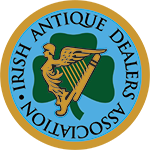Irish Jewellery - A Short History
A visitor to Dublin Castle in the eighteenth century would have traversed streets and laneways peppered with the gleam of gold and silver, shop windows glinting with plate and jewels, and stalls heaving with treasures untold. The streets stretching from Christ Church to Capel Street formed an epicentre of the precious metal trade in eighteen-century Ireland and sixty percent of the trade was located there.
The Irish jewellery manufactured and worn was usually in keeping with European fashions and Irish customers were particularly eager to emulate London styles. Some of the more widely worn items of jewellery were those which bore a practical function, such as shoe buckles and watches. Despite the fact that such items were manufactured in their thousands few survive and thus this watch by Edward Hawkesworth is a rare example of its type Hawkesworth, described as a silversmith and watchmaker, operated from 18 Grand Parade in Cork from 1824-56. The trades of watchmaker and watchcase maker were two distinct specialisations and thus it is not unusual that Hawkesworth’s movement is set in a London case.
From the beginning of the nineteenth century, a fashion for more distinctly Irish jewellery pieces emerged. The archaeological excavations occurring in Ireland and Europe led to a renewed interest in antiquarianism. Jewellers responded to this fashion by creating pieces based on distinctly Irish motifs. This brooch by Edmond Johnson is a stunning and rare example if Celtic Revival jewellery.
Johnson was the leading goldsmith and jeweller in Dublin from the late nineteenth century, famously remembered for making the Liam McCarthy cup. Owning to the contemporaneous fashion for native materials, the brooch is almost certainly set with Irish river pearls. Irish seed pearls were highly desired and customers in London often requested for their jewellery to be set with the native gems. Once bountiful, Irish pearls are sadly now practically obsolete owing to pollution, making this piece all the more exceptional.
Also of note is this Fenian Claddagh ring. Synonymous with the Fenian movement from 1850-1900, the removal of the crown on the ring symbolised the Fenians’ desire to be free of British rule.
Very little Irish jewellery from this period survives and extant pieces like these are few and far between. For jewellery enthusiasts, these museum-worthy pieces offer a rare chance to acquire a piece of Irish design history, increasingly rare treasures of times gone by.



 eCommerce Development
eCommerce Development